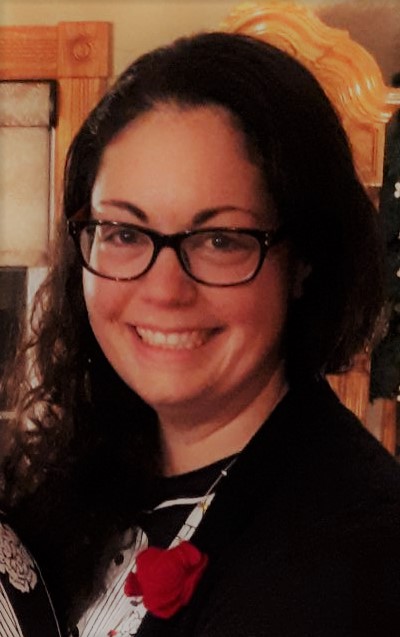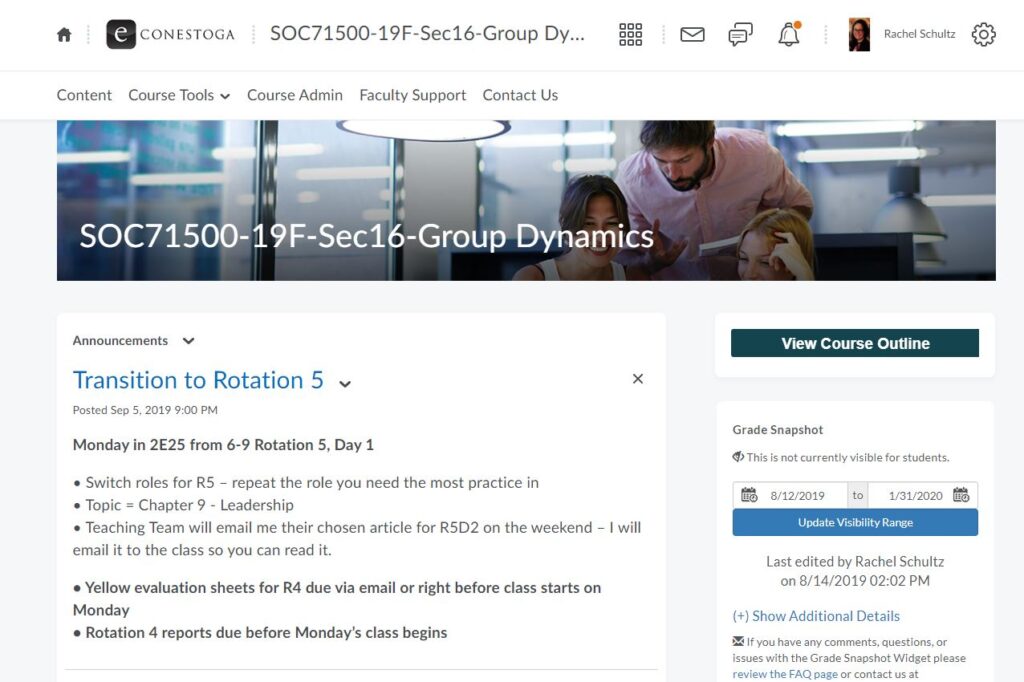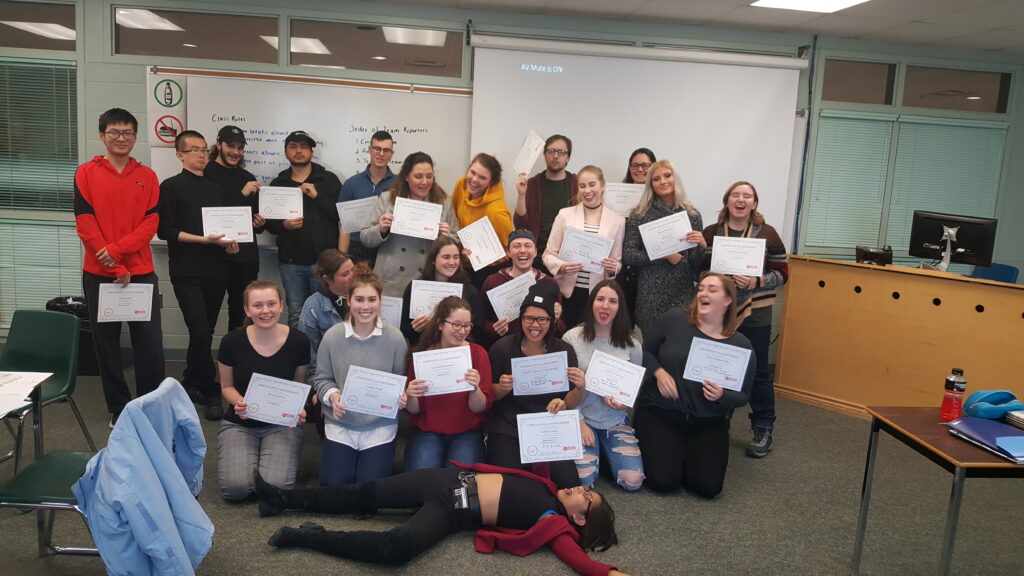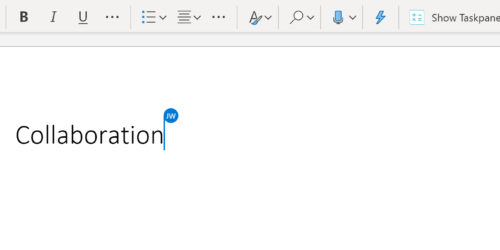Building Future Teamwork Success in Group Dynamics Course
By Rachel Schultz, B.A., B.Ed., M.Ed, OCT, TESL
Professor, School of Interdisciplinary Studies
This Teaching Story describes the Group Dynamics course that is a foundation of a number of programs at Conestoga College. The course continues to grow and evolve as it is adapted to remote delivery.
Group Dynamics

I have been a faculty member with Interdisciplinary Studies for about 13 years. My practical and theoretical background in educational psychology and experience teaching a wide range of students from kindergarten to adults made me a good fit to guide Conestoga students through the Group Dynamics course (SOC71500 and COMM1030). As a member of the Group Dynamics ‘Consultant’ team, part of my role involves modeling professional group dynamics and continual development and refinement of the course.
Group Dynamics is an experiential course that provides a structured opportunity for students to actively apply textbook theory to their real live interpersonal tasks, roles, and situations. The primary goal of the Group Dynamics course is to develop self-regulated group members who have the capacity to add value to their future teams through their practice in organizing, troubleshooting, and performing as a team.
The Group Dynamics course, originally developed by now retired Liberal Studies professor Bruce Bjorkquist, has been offered at the College for a few decades. It is part of the Foundations model, which runs at the Cambridge campus for a number of degree programs, including Bachelor of Interior Design, Architecture – Project and Facility Management, and various engineering fields. The Foundations model is a delivery of the course in which students receive the course credit in advance of beginning the fall term. This is because the program believes that knowledge of group dynamics is so crucial for the rest of the program that it needs to come first.
This condensed course runs for four weeks at a time. It begins in mid-August, and for the first two weeks the course runs in the daytime. Then, in September when the other fall courses begin, the course switches to every other night at the Doon. There are usually 25 students or less per section (lower numbers are ideal) in order to facilitate student group organization.

Student Involvement in Course Delivery
In the Group Dynamics course, students teach themselves about effective group functioning with consultation from the professor and the support of a built-in multifaceted evaluation process.
Every team has an active role to play in every class. Team and individual roles are rotated every two classes. Team roles are: Executive, Review, Teaching, Energizer, and Evaluation. Students rotate through a variety of group and individual roles in five teams of three to six people, while collaborating with the class to learn course content.
The student teams are charge of organizing every class session, including the exam. The faculty member arrives to class, is seated, and then becomes a ‘fly on the wall’ observer for the first two hours of the class session. Faculty take detailed feedback notes while Executives deliver the class session to other students.
The faculty plays a significant role in balanced evaluation every class. After students have run through their roles, faculty give feedback to all groups in front of the class, and then sit down with groups in the last hour to provide guidance/check ins. Sometimes faculty are invited to attend outside of class group meetings of teams in conflict or to have ‘interventions’ for particularly disruptive behaviour. It’s not uncommon for a prof to stay well after class to support a team (whether they are having problems or just want advice to extend themselves).

Over the course of my involvement with Group Dynamics course, I have witnessed many moments of exceptional cooperation among students. I am always amazed by the work and bonding that happens in Foundations, and often see groups continue to work together until the end of the program. The students are my heroes for their sacrifices to their teams and rapid personal growth in this short course!
Group Dynamics in Remote Delivery
Courses with group work projects can be logistically challenging for students to complete. Different schedules, meeting times, personalities, and professional learning goals are some of the factors that make group work challenging, whether they are working together face to face or remotely.
Our Groups Consultant team is currently working to plan remote delivery of the course for start in mid-August 2020. Opportunities include addition of professional online behaviour reflected in updated sections of the team contract that every group completes. We hope to incorporate Teams, Zoom, collaborative online documents, and pre-recorded videos to help support students learning and working remotely in groups.
We will continue to use team contracts during remote delivery. Team contracts are critical to ensure teams have a shared understanding of how to work together, and will need to take into account how to better negotiate space for students with children and jobs, unstable living or economic situations, inadequate access to technology, and the other real-life experiences of our students.
I’m confident that with the expert knowledge of the team informed by the feedback of hundreds of Group Dynamics Alumni, the tenacity of our student population, and application of course concepts, we’ll be able to successfully navigate the transition to remote delivery. Our students continue help us every day to improve what we do for them!
Tips for Promoting Healthy Group Dynamics in Courses
Even without the Foundations model, professors can work to ensure that student teams will be successful in group assignments. Here are three planning tips.
- Prioritize learning outcomes: When assigning group assessments, consider first how you are addressing your course learning outcomes. Purposefully craft your group work evaluations in ways that appropriately scaffold the group experience for your students with templates and modeling.
- Use check-ins and feedback: Include a draft, planning, or proposal check-in point in group evaluations that provides a structured opportunity for students to show you where they think they are going in the task. You are then able to provide feedback to motivate, course correct, or refine. This section should be graded (it does take work to plan, after all!), Award marks for process and accountability – what tasks need to be completed to achieve the stated goal? Which team member is responsible for each task? When are the deliverables due and who submits them?
- Provide manageable growth opportunities: Ensure all group members are able to engage with the team project in ways that are both comfortable, but also that can extend abilities – students will always rise to meet course outcomes and educational experiences that are well aligned and personally meaningful. Remember that each student must provide an opportunity to present achievement of the course outcomes on the evaluation.
For more information on group work contracts, see the teaching tip, Team Contracts for Healthy Remote Group Work.



